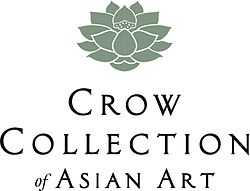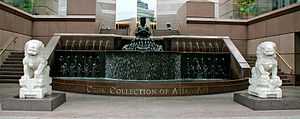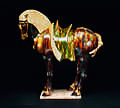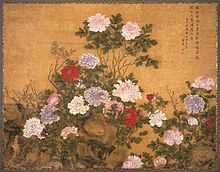Trammell & Margaret Crow Collection of Asian Art
| The Crow Collection | |
|---|---|
 | |
| Established | 1998 |
| Location | Dallas, Texas |
| Coordinates | 32°47′16″N 96°48′00″W / 32.787767°N 96.799983°W |
| Type | Asian art |
| Collection size | Over 4,000 pieces |
| Director | Amy Lewis Hofland |
| President | Trammell S. Crow |
| Curator | Dr. Caron Smith |
| Website | www.crowcollection.org |
The Trammell & Margaret Crow Collection of Asian Art, also known as the Crow Collection of Asian Art, is a museum dedicated to the arts and cultures of China, Japan, India and Southeast Asia, located in downtown Dallas, Texas (USA). The Crow Collection opened to the public on December 5, 1998, as a gift to the people and visitors of Dallas from Mr. and Mrs. Trammell Crow. The museum is a member of the Dallas arts district.
History

Trammell Crow and Margaret Crow bought their first piece of Asian art in the mid-1960s. The Crows have traveled extensively throughout the world, but Asia was a favorite destination. Pieces from China, Japan, India and other Southeast Asian countries were added as the Crow's travels continued, evolving into a distinguished collection featuring artwork spanning 3500 B.C. to the early 20th century.
The idea for the museum came about when Mr. and Mrs. Crow decided they would like to keep the collection intact as a legacy for their children, grandchildren and the general public. The artwork, which ranges from including examples of Chinese jades, Buddhist sculpture, and Japanese screen paintings, had been displayed in lobbies, reception and office areas of the Trammell Crow Center, other office buildings, marts, hotels, and in the homes of the Crows and their children prior to the formation of a museum. "Because the art was scattered between commercial buildings and our families' homes, we had little notion of what kind of a collection we had until pieces were gathered for the exhaustive selection process," Mrs. Crow said.
In total, the Crow family has amassed more than 4,000 pieces of Asian art, among which the 569 best were selected, after extensive analysis, by a noted curator for inclusion in The Crow Collection. At that point, the interior of the Pavilion at the Trammell Crow Center was redesigned and renovated to meet the special needs of a gallery displaying centuries-old art year-round. A son of the family, Trammell S. Crow, serves as president of the Crow Family Foundation and oversees the development of The Crow Collection.
Permanent collection

The majority of works comprising the Trammell and Margaret Crow collection have been obtained from individual purchases through private dealers and auction houses, as well as through the acquisition of major collections, such as the highly respected Morrie A. Moss collection. The Crow Collection of Asian Art has three galleries.
Gallery I, located on the first floor, is where Japanese art is exhibited, except when travelling exhibitions are on display. The Lotus Shop and garden flank Gallery I. Gallery II occupies the second floor. Chinese artifacts are displayed in Gallery II, as well as in the mezzanine. The Jade collection, one of the finest in the US and a pillar of the Crow Collection, is located here. Most of the items are from the 18th century, when the traditional Chinese jade industry (before the arrival of the industrial age) reached its zenith. A number of Qing Dynasty snuff bottles are on display as well.
The Skybridge, a glass structure held up by steel beams connecting Gallery II and Gallery III, offers views of the Nasher Sculpture Center, the Trammell Crow Center, and overlooks The Seated Daoist Deity fountain. Gallery III is the primary site for works of art from Southeast Asia and India. Gallery III is dominated by the Mugal wall, which is hung from the ceiling due to its extreme weight, and two Indian gazebos. One of these "baradari," used in gardens of Indian palaces and residences for relaxation and meditation, spent years at the Crow family farm in East Texas before its selection for the collection.[1]
Gallery
-

Tang Dynasty Horse, China, 8th century[1]
-

China, Qing dynasty, Kangxi period, 1672 Ink and pigment on silk[1]
-

China, Qing dynasty, 18th century Glass[1]
-

West India, Rajasthan, Mughal period, 18th century Sandstone [1]
-

Cambodia, pre-Angkor period, 7th century Sandstone[1]
-

The skybridge connecting Gallery II to Gallery III.
-

Japan, Edo period, Kano-school style, 1850 Pair of six-fold screens; ink, pigment, silver and gold leaf on paper; wood, silk, and lacquer[1]
-

China, Qing dynasty, Qianlong period, 1762 Nephrite and gilding [1]
- ^ Cite error: The named reference
The_Trammell_2008was invoked but never defined (see the help page).
Past exhibitions
- Touching the Mekong: A Southeast Asian Sojourn (2006) displayed contemporary black-and-white photography depicting life in Southeast Asia. Over 50 images taken by photographer Andrea Baldeck in 2001 and 2002, documented the cultures and the lives of people living in Vietnam, Myanmar, Cambodia and Laos.[2]
- The Spinnaker Collection of Chinese Snuff Bottles (2007) documented the Imperial workshops of Qing Dynasty China (1644–1912) which served Emperors, aristocrats and literati of the era.[2]
- Changing Identity: Recent Works by Women Artists from Vietnam (2007) introduced the work of ten contemporary Vietnamese women artists who challenge the stereotypes and traditional roles of women in Vietnamese society, the first survey of its kind to tour the United States. Two generations of artist's views of their country and the changing status of women, reflecting a diverse range of opinions and experiences.[2]
- Texas Collects Asia (2008) was a series of exhibitions to celebrate The Crow Collection of Asian Art's ten-year anniversary. Five exhibitions covered Japanese art in general and Japanese Folk Art in particular, India and Southeast Asian art, Chinese art, and Contemporary art representing the regions.[2]
- Untamed Beauty: Tigers in Japanese Art (2009) was an exhibition showing the animal's portrayal by twenty-one of Japan's most famous painters of the last three hundred years.[2]
- Yeohlee: Design For Now (2009) was the first major exhibition in Dallas of Yeohlee and featured selected fashion designs and concepts from her 2004–2009 collections, focussing on the evolution of her approach to design, which closely parallels architectural concerns but is ultimately attentive to the body.[2]
- Modern Twist: Bamboo Works from the Clark Center and the Art of Motoko Maio (2010) explored the intersection of tradition, innovation, and design by pairing a selection of basket-making works from the Clark Center in Hanford, California, and the screen-making work of Motoko Maio.[2]
- New Vision: Ballpoint Drawings by Il Lee (2010) explored the language of modernism in Korean-American artist Il Lee's minimalistic representations of line and form, and the contemporary possibilities of drawing and painting in his chosen medium of ball point pen.[3]
The Trammell Crow Center

Located in the Dallas Central Business District, the Trammell Crow Center stands at a height of 686 feet (209 m) and is the sixth-tallest building in Dallas and the 18th-tallest in Texas. The building totals 1,200,000 square feet (110,000 m2) on 50 floors and has a polished and flamed granite exterior with a garden plaza and is bordered by the Crow Collection. There are many museums available in close proximity to the building: the Nasher Sculpture Center, the Winspear Opera House, and the Dallas Museum of Art.
References
- ↑ The Trammell & Margaret Crow Collection of Asian Art. Dallas: The Trammell & Margaret Crow Collection of Asian Art, 2008, ISBN 978-0-9622743-9-8.
- ↑ 2.0 2.1 2.2 2.3 2.4 2.5 2.6 http://crowcollection.org/explore/exhibitions/past/
- ↑ Simek, Lucia (June 7, 2010). "Il Lee's Large Ballpoint Pen Drawings". exhibition: Crow Collection. D Magazine Partners, Inc. Retrieved April 2013.
External links
| Wikimedia Commons has media related to Crow Collection of Asian Art. |
- The Trammell & Margaret Crow Collection of Asian Art Official website
Coordinates: 32°47′16″N 96°48′00″W / 32.787767°N 96.799983°W